June 30, 2010 — A 100-foot tall rocket rolled into Houston last week to join the small collection of very large launch vehicles populating the rocket park at the NASA Johnson Space Center (JSC) in Texas.
The Gemini-Titan, which for decades stood in the rocket garden at the Kennedy Space Center in Florida, arrived in four large parts on trucks last Wednesday and Thursday. The delivery was made with little fanfare or notice.
The rocket, which will need repair and restoration before it can be erected for display, is presently parked behind a property disposal building at the back of the center, out of sight of most employees and the public.
The addition of the Gemini-Titan to JSC's rocket park will help complete two time lines from NASA's history. Joining the Mercury-Redstone — the vehicle that put the first U.S. astronaut into space — and the Little Joe II and Saturn V rockets that enabled Americans to walk on the Moon, the Gemini-Titan will bridge the evolution of the United States' early manned spacecraft.
The rocket will also help tell local NASA history. The two- man Gemini was the first program managed from Johnson — then known as the Manned Spacecraft Center — after its foundation in 1963. The center's Mission Control entered service with the Gemini IV mission, which launched June 3, 1965, three weeks and 45 years before the Titan landed at the center for display.
"It's the missing piece," remarked Paul Spana, exhibits manager for Space Center Houston, the visitor center for JSC. "We've got the Apollo and Mercury-Redstone but we don't have anything that represents the Gemini out there. So this is going to add that missing piece to the story about the history of manned spaceflight... and Johnson Space Center."
Swapping stages, replacing rockets
The Gemini-Titan was initially removed from the Kennedy Space Center Visitor Complex in June 2006 after a series of strong storms led its curators to believe that it was at the greatest risk of being damaged.
"The Gemini-Titan was in serious need of restoration and preservation work, as it was starting to become a risk for the hurricane season," explained NASA exhibits developer Luis Berrios.
The removal was not unusual said Berrios, as each of the standing rockets had been lowered from time to time for refurbishing. The Gemini-Titan had previously been taken down in 1996.
At first, the plan was to reinforce the rocket and re-erect it in the garden but two factors — both related to the Titan II's two stages — ultimately altered its fate.
The man-rated Titan II missiles that launched the two-seat Gemini spacecraft consisted of two stages. The Titan on display at Kennedy (and now at Johnson) however, was assembled from available parts.
"The mock-up was made of two first stages," said Berrios.
The removal of the replica spacecraft and upper 'second' first stage went without issue, but as workers lowered the 'first' first stage, it split into two pieces.
That damage may have been repaired had it not been for the fortuitous find of an available two-stage Titan missile.
"We had the opportunity to transfer some Titan II retired ICBM stages from the AMARG [Aerospace Maintenance and Regeneration Group, the Air Force's boneyard] out in Tucson, Arizona," stated Berrios. "They were due to be discarded — we caught them just in time — just before they were turned into scrap metal and shredded up forever."
With a more-accurate Gemini-Titan being constructed for display at the Kennedy Space Center, Berrios reached out to his counterpart at JSC to offer the older rocket.
"The opportunity came up to excess the rocket we took down and that is when the folks over at Johnson Space Center decided to transfer it to their center, so they could have a Gemini out there, too," Berrios said.
Not launching anytime soon
Even if the Titan now in Houston had its two stages (and other missing components, including an interstage support structure), it would still be missing a critical component to complete its display.
"On the one we transferred, we cut the engines to make sure we had all the parts to complete our replica rocket," revealed Berrios.
The Gemini-Titan's first stage was powered by two Aerojet LR87 liquid propellant rocket engines. The second stage was outfitted with a single LR91 engine.
Louis Parker, Berrios's equivalent at Johnson, says that in addition to having engineers assess its restoration, there is yet another key element that must be identified before the Gemini-Titan can be raised in the rocket park.
"We have to find center funds to do all this... and that may be a challenge, but I have the Center Ops Directorate behind the project, so hopefully, it will be done sooner rather than later," explained Parker.
All things considered — including where to physically place the rocket — Parker estimates it may be 2011 before the Gemini-Titan is ready.
"I would estimate that it may be after the first of the year before we're ready to do any erecting, if by then," he said.
Rare rockets
Despite having launched a dozen Gemini spacecraft — 10 of them manned — between 1964 and 1966, only a handful of Gemini-Titan-configured rockets are on display today.
In addition to Kennedy's 'new' rocket, which is set to debut in late August or early September, and the booster now at Johnson, A Field Guide to American Spacecraft lists just four other Gemini-Titans on display. The online Guide, as its name implies, tracks the current whereabouts of United States historic space vehicles.
By comparison, the Guide identifies 10 Mercury-Redstone displays, including the one in JSC's rocket park, and that rocket only flew six times and was manned only twice.
A mock Gemini-Titan stands at the Kansas Cosmosphere and Space Center in Hutchinson, as does another at the New York Hall of Science in Corona Park. The latter was first erected for the 1964-1965 New York World's Fair and was recently restored.
A retired Titan II missile, painted as the Gemini IX launch vehicle, is on horizontal display inside the Stafford Air and Space Museum in Weatherford, Oklahoma. The museum is named for Gemini IX commander Thomas Stafford.
The Field Guide also notes the since-closed exhibit of a Gemini-Titan mock-up in Bayamón, Puerto Rico. The full scale replica stands at the Parque de las Ciencias Luis A. Ferré (Luis A. Ferre Science Park).
Gemini was NASA's second manned program, dedicated to developing and demonstrating the skills necessary for sending astronauts to the Moon. Among the records first set by Gemini missions was the first American spacewalk and the first rendezvous between two manned spacecraft. |
|
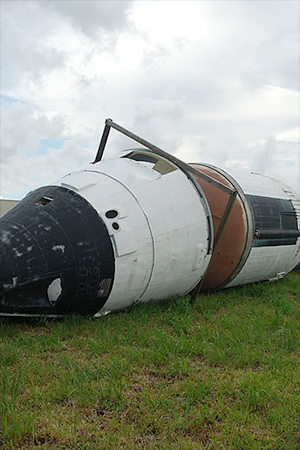
A Gemini-Titan rocket display lies on its side, awaiting its repair and restoration at NASA's Johnson Space Center. (collectSPACE)
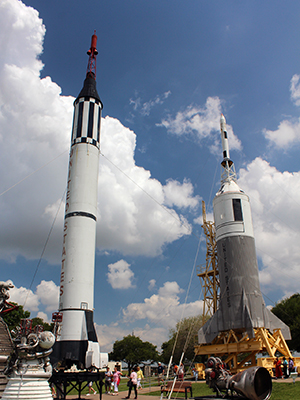
A Little Joe II and Mercury-Redstone currently stand on display in Johnson Space Center's rocket park. (Wally Gobetz)
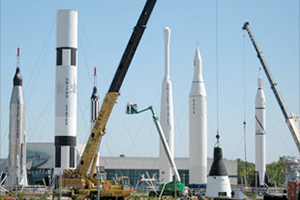
Cranes begin lowering the Gemini-Titan booster from Kennedy Space Center's rocket garden in June 2006. (Jim Gerard/AFGTAS)
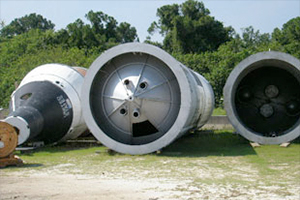
Gemini-Titan components await being shipped from Kennedy to Johnson Space Center. (Paul Spana/Space Center Houston)
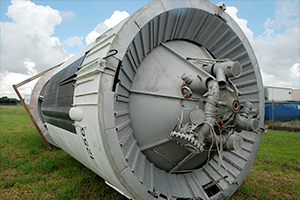
The base of the Gemini-Titan as it lies at Johnson Space Center, without its Aerojet LR87 engines. (collectSPACE)
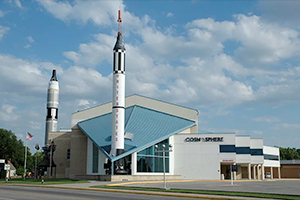
Gemini-Titan and Mercury-Redstone rockets on display outside the Kansas Cosmosphere and Space Center. (collectSPACE) |
